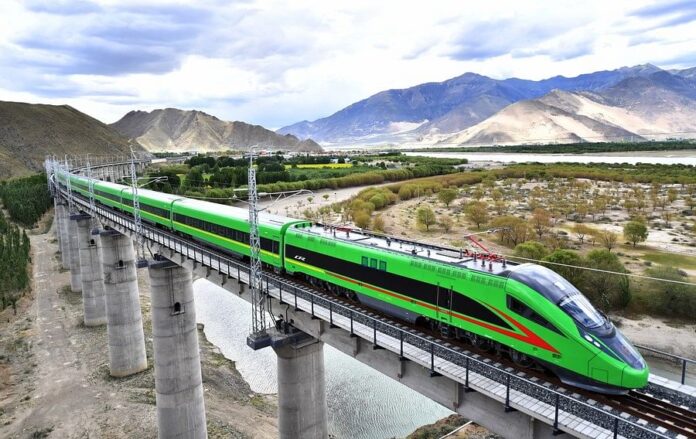(TibetanReview.net, Jun25’21) – China has brought its high-speed railway line in occupied Tibet to India’s doorstep days earlier than planned, opening the Lhasa-Nyingchi Railway on Jun 25. For the first time, Fuxing bullet trains will pass through southeast Tibet, shortening the journey between Tibet’s ancient capital Lhasa, and Nyingchi (Tibetan: Nyingtri) by 3.5 hours, reported China’s official cgtn.com Jun 25.
Nyingtri is not only located close to the border with the Indian state of Arunachal Pradesh but it is also a major tourist attraction with sprawling Chinese-immigrant populated areas.
Only very recently, China said the service will open on Jun 30, the eve of the centenary of the Communist Party of China, as a ‘gift’ to Tibet.
Over 90% of the track are at an elevation of more than 3,000 meters above sea level, with the highest point being at 5,100 metres, a record height for any electrified railways worldwide, the report said.
There are a total of nine railway stations on the railway line – Gonggar, Zhanang, Shannan, Sangri, Gyaca, Nang County, Mainling, Gangga, and Nyingchi. The report said all have both passenger and freight services.
The 435 km Lhasa-Nyingchi Railway, with a designed speed of 160 km per hour, is part of the ambitious Sichuan-Tibet Railway still under construction, that will connect Lhasa and Chengdu, the capital of neighbouring Sichuan Province.
It also shares lines with the planned railway connecting southwest China’s Yunnan Province and Tibet, the report noted.
The construction of the railway began in Mar 2015 and more than 130,000 workers had been labouring in the mountains to build the railway, said an official Xinhua news agency report Jun 25.
The rail line passes through 47 tunnels and 121 bridges, and crosses the Yarlung Zangbo River 16 times. Tunnels and bridges account for approximately 75% of the total length of the railway, which meant challenges for construction workers and provided valuable experience for the construction of railways on plateaus, then report said.
The report put the railway’s annual freight transport capacity at 10 million tonnes.
The railway also has a great strategic role. In November, Chinese President Xi Jinping had instructed officials to expedite its construction, saying it would play a key role in safeguarding the border stability.
Also, Qian Feng, director of the research department at the National Strategy Institute at Tsinghua University, told the official daily Global Times earlier that “If a scenario of a crisis happens at the China-India border, the railway will provide a great convenience for China’s delivery of strategic materials.






